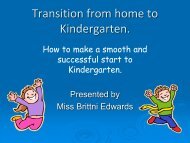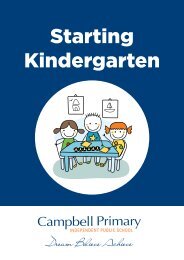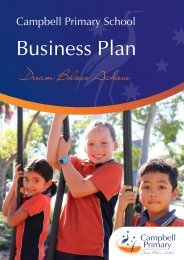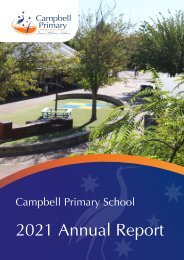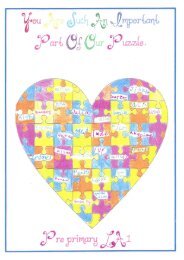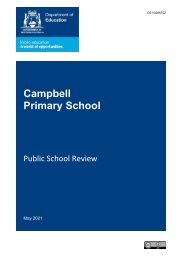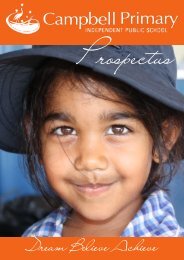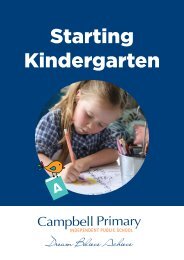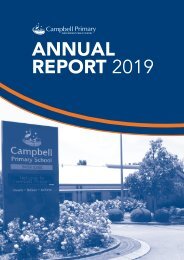Protective behaviours parent resource
Create successful ePaper yourself
Turn your PDF publications into a flip-book with our unique Google optimized e-Paper software.
<strong>Protective</strong> <strong>behaviours</strong><br />
Parent <strong>resource</strong><br />
Schools and <strong>parent</strong>s working together<br />
to help keep children safe
Quote by<br />
Peg Flandreau West<br />
Developer of the first protective <strong>behaviours</strong> program<br />
November 1988<br />
I continue to be astounded at how many children and adults are telling us how they’re<br />
using <strong>Protective</strong> Behaviours to change their lives and cherish themselves. I have<br />
enhanced my own creativity, increased my life energy and sharpened my sense of<br />
adventure. How strange it was at first, to realize that work involving something as<br />
painful as violence could involve laughter and joy. For as we move beyond reaction to<br />
violence, we are moving into the alternatives of empowerment, we are finding new<br />
ways to get through painful times. We are finding, even in the midst of it all,<br />
excitement, creativity, laughter and adventure for ourselves.
<strong>Protective</strong> <strong>behaviours</strong><br />
Parent <strong>resource</strong><br />
Schools and <strong>parent</strong>s working together to<br />
help keep children safe<br />
This <strong>resource</strong> is designed as a guide to protective <strong>behaviours</strong> for <strong>parent</strong>s and carers.<br />
© Copyright Department of Education, Western Australia and <strong>Protective</strong> Behaviours<br />
WA Inc. All Rights Reserved. This <strong>resource</strong> has been provided for the purpose of<br />
informing <strong>parent</strong>s and caregivers about the Department of Education’s protective<br />
<strong>behaviours</strong> program only and must not be forwarded to or reproduced by any other<br />
person or organisation. No part of this book may be reproduced in any form without<br />
written permission of the copyright owners. No responsibility is accepted by the<br />
producer, publisher, or printer for any infringement of copyright or otherwise, arising<br />
from the contents of this publication.<br />
Acknowledgements<br />
This <strong>resource</strong> has been developed by <strong>Protective</strong> Behaviours WA Inc. in<br />
collaboration with the Department of Education, Western Australia.
Contents<br />
About the protective <strong>behaviours</strong> <strong>parent</strong> <strong>resource</strong> ............................................... 2<br />
Types of abuse ................................................................................................... 3<br />
Theme one: We all have the right to feel safe ................................................... 4<br />
Rights and responsibilities .................................................................................. 5<br />
Feelings .............................................................................................................. 6<br />
Early warning signs ............................................................................................ 8<br />
Safety ............................................................................................................... 10<br />
One step removed problem solving .................................................................. 11<br />
Body awareness and ownership ....................................................................... 12<br />
Public or private ................................................................................................ 14<br />
Body safety songs ............................................................................................ 15<br />
Safe and unsafe touch ..................................................................................... 16<br />
Personal space ................................................................................................. 17<br />
Theme two: We can talk with someone about anything, no matter what it is .. 21<br />
Safe and unsafe secrets ................................................................................... 22<br />
Networks .......................................................................................................... 23<br />
My helping hand checklist ................................................................................ 24<br />
My helping hand ............................................................................................... 25<br />
Invitation ........................................................................................................... 26<br />
Assertiveness ................................................................................................... 28<br />
Make your own family safety plan .................................................................... 30<br />
Additional information for <strong>parent</strong>s ..................................................................... 31<br />
Keeping children safe online ......................................................................... 32<br />
Grooming ...................................................................................................... 33<br />
Telephone helplines ...................................................................................... 35
About the protective <strong>behaviours</strong><br />
<strong>parent</strong> <strong>resource</strong><br />
Although every child has the right to feel safe at all times, each year thousands of<br />
children across Australia experience abuse. It is estimated that 1 in 4 girls and 1 in 7<br />
boys will be subject to some form of unwanted sexual activity before the age of 18<br />
(Australian Institute of Criminology, 1993).<br />
The protective <strong>behaviours</strong> program is based on two themes:<br />
We all have the right to feel safe at all times<br />
We can talk with someone about anything, no matter what it is<br />
By sharing protective <strong>behaviours</strong> with your child, you will be helping to develop lifelong<br />
skills of assertiveness, self-confidence, problem solving, communication, resilience and<br />
help seeking.<br />
You will find that the activities and discussions in this handbook are simple and<br />
presented in a fun, child-friendly way, designed not to frighten children but inform them<br />
of some of the vital skills of personal safety.<br />
How to<br />
use this<br />
<strong>resource</strong><br />
Pencil icon<br />
Complete this activity with your child<br />
Light bulb bubble<br />
Provides further ideas and discussion topics<br />
for you and your child<br />
Speech bubble<br />
Reinforce the two themes with your child in<br />
everyday life<br />
2
Types of abuse<br />
In Western Australia, under the Children and Community Services Act 2004, a child is<br />
a person under the age of 18 years.<br />
There are generally four types of child abuse and neglect, which may co-exist:<br />
Physical abuse occurs when a child is severely and/or persistently hurt or injured by<br />
an adult or a child's caregiver. It may also be the result of putting a child at risk of being<br />
injured.<br />
Some examples are: hitting, shaking, punching; burning and scolding; excessive physical<br />
punishment or discipline; attempted suffocation; shaking a baby.<br />
Child sexual abuse occurs when a child is exposed to, or involved in, sexual activity<br />
that is inappropriate to the child’s age and developmental level. It includes circumstances<br />
where the child has less power than another person involved, is exploited or where the<br />
child has been bribed, threatened, or coerced. It also includes situations where there is a<br />
significant difference between the developmental or maturity level of the child and another<br />
person involved.<br />
Some examples are: letting a child watch or read pornography; allowing a child to watch<br />
sexual acts; fondling the child’s genitals; having oral sex with a child; vaginal or<br />
anal penetration; using the internet to find a child for sexual exploitation.<br />
Emotional abuse occurs when an adult harms a child’s development by repeatedly<br />
treating and speaking to a child in ways that damage the child’s ability to feel and express<br />
their feelings.<br />
Some examples are: constantly putting a child down; humiliating or shaming a child; not<br />
showing love, support or guidance; continually ignoring or rejecting the child; exposing the<br />
child to family violence; threatening abuse or bullying a child; threats to harm loved ones,<br />
property or pets.<br />
Emotional abuse also includes psychological abuse and exposure to family and domestic<br />
violence.<br />
The term family violence most commonly refers to violence and abuse against an intimate<br />
partner (including same sex relationships and ex-partners) but can also occur between<br />
siblings, from adolescents to <strong>parent</strong>s, or from family carers to a relative. It can include the<br />
abuse of children and young people, older people, people with a disability, and other family<br />
members.<br />
Neglect is when a child is not provided with adequate food or shelter, effective medical,<br />
therapeutic or remedial treatment, and/or care, nurturance or supervision to a severe<br />
and/or persistent extent where the health or development of the child is significantly<br />
impaired or placed at serious risk.<br />
Some examples are: leaving a child alone without appropriate supervision; not ensuring the<br />
child attends school, or not enrolling the child at school; infection because of poor hygiene<br />
or lack of medication; not giving a child affection or emotional support; not getting medical<br />
help when required.<br />
SOURCE: Department of Communities, Child Protection and Family Support<br />
3
Theme one: We all have the right to<br />
feel safe<br />
A human right that<br />
we are all born<br />
with cannot be<br />
taken away and<br />
does not have to<br />
be earned<br />
All of us<br />
you, me,<br />
friends, family,<br />
strangers…<br />
everyone<br />
Physical and<br />
emotional safety<br />
It’s a personal,<br />
individual experience<br />
24 hours a day<br />
In the morning, during the<br />
day, at night time, at home,<br />
at school, at grandma’s,<br />
at after school care<br />
4
Rights and responsibilities<br />
What can I do?<br />
<br />
Explain to your child that with every<br />
right comes a responsibility.<br />
For example:<br />
You have the right to a good education<br />
You have the responsibility to do your<br />
best at school<br />
You have the right to voice your opinion<br />
You have the responsibility to respect<br />
the opinions of others<br />
5
Feelings<br />
Our bodies give us lots of different feelings. It is an important part of personal<br />
safety to show your child how to recognise, understand and express their feelings.<br />
Being in charge of our feelings is important in developing self-confidence and<br />
responsibility.<br />
What can I do?<br />
<br />
<br />
<br />
<br />
<br />
<br />
<br />
Help your child to expand their feelings<br />
vocabulary. Help your child to name and trust<br />
their feelings when they do not feel safe.<br />
Help develop their ability to recognise,<br />
understand and express their feelings<br />
appropriately.<br />
Be understanding and accepting of your child<br />
expressing a range of feelings. When your child<br />
expresses or shows unhappy or sad feelings<br />
ask, “How would you like to feel? What could<br />
you do so that you feel happy/safe?”<br />
Assist your child to recognise others’ feelings.<br />
Be a role model by owning your own feelings<br />
using the “I feel… when…” format.<br />
Role play using their toys and puppets to<br />
explore feelings further.<br />
Use a mirror to help your child see their facial<br />
expressions and physical body reactions for<br />
each feeling.<br />
6
7
Early warning signs<br />
Early warning signs are the involuntary physical sensations that take place in<br />
our bodies in reaction to potentially unsafe situations.<br />
Our early warning signs alert us to danger or threats to our safety. Early warning signs<br />
may differ from one person to another, but we all have them.<br />
Children can learn to identify their early warning signs. Early warning signs can be fun<br />
and enjoyable when we have choice and control over what’s happening to us.<br />
What our bodies say:<br />
<br />
<br />
<br />
<br />
‘My heart is beating really fast!’<br />
‘There are butterflies in my tummy!’<br />
‘My legs feel weak and I have jelly knees!’<br />
‘My mouth is so dry!’<br />
Other early warning signs can include:<br />
<br />
<br />
<br />
<br />
tight shoulders<br />
sweaty palms<br />
red cheeks<br />
goose bumps<br />
What can I do?<br />
<br />
<br />
Talk with your child about what happens in<br />
their bodies when they start to feel scared<br />
or worried. What early warning signs<br />
(physical sensations) do they feel? Use<br />
examples from your own experiences, e.g.<br />
when you’re running late for an<br />
appointment.<br />
Watch for times when you think your child<br />
may be feeling scared or worried<br />
(examples are, high swings, going<br />
somewhere new, first day in a new class).<br />
Ask them to identify where in their body<br />
they can feel their early warning signs.<br />
Encourage your child to pay attention to<br />
their early warning signs and tell you when<br />
and where they happen.<br />
<br />
<br />
Try some fun, enjoyable activities or<br />
games where there is a build-up of<br />
anticipation to assist your child to<br />
describe their own early warning signs.<br />
Some examples are jack-in-the-box,<br />
pop up pirate, tower of blocks,<br />
snapping crocodile, egg and spoon<br />
race, ‘What’s the time Mr Wolf?’.<br />
Encourage them to practise taking<br />
slow breaths when they start to feel<br />
scared. Explain that this helps them<br />
think clearly and decide what to do.<br />
<br />
Avoid telling your child not to feel scared,<br />
or that they are silly to feel scared. Instead,<br />
provide understanding, reassurance and<br />
encouragement to problem-solve the<br />
situation.<br />
8
Early warning signs<br />
What early warning signs does your body give you when you are feeling unsafe or<br />
doing something that is fun or scary?<br />
Draw or write your early warning signs<br />
If I get my early warnings signs and I feel unsafe,<br />
it is important to tell an adult who I trust.<br />
I can keep telling until my early warning signs go away<br />
and I feel safe again.<br />
9
Safety<br />
Safety is a physical state. The protective <strong>behaviours</strong> program stresses the need<br />
to ‘feel’ safe, as well as ‘be’ safe, recognising the importance of psychological or<br />
emotional safety.<br />
Safety involves having informed choice and control over any situation in which<br />
we find ourselves.<br />
Safety = Choice = + Control + A Time Limit<br />
Cho<br />
Feeling safe and adventurous go hand in hand when we maintain our choice and<br />
control. Each of us has experienced feeling safe and unsafe and these situations may<br />
be quite unique to the individual. Examples are feeling safe or unsafe around a dog, or<br />
feeling safe or unsafe in the dark.<br />
Recognising the difference between feeling safe and unsafe is a crucial part of the<br />
protective <strong>behaviours</strong> program. As a <strong>parent</strong>, you cannot define a safe or unsafe<br />
situation for your child. You can, however, help your child to recognise when they may<br />
be feeling unsafe by identifying their early warning signs and help them choose<br />
strategies that assist them to have choice and control in any particular situation.<br />
When children feel safe, they talk about feeling: loved, warm, secure, noticed, happy,<br />
in control, trusted…<br />
Some common feelings associated with feeling unsafe are awful, stupid, stuck, left out,<br />
powerless, stressed, shaky…<br />
What can I do?<br />
<br />
<br />
Encourage your child to draw a picture of a<br />
place where they feel safe – this is referred to<br />
as their ‘safe place’. Discuss with your child<br />
what their ‘safe place’ looks like, smells like,<br />
how they feel when they are there, what they<br />
can hear in their ‘safe place’. A child may<br />
have several ‘safe places’.<br />
Talk about ways that someone who is feeling<br />
unsafe could help themselves feel safe again.<br />
10
One step removed problem solving<br />
A good way to help children practise<br />
the skills to keep themselves safe is to<br />
play problem solving games. It is often<br />
less frightening for a child to pretend<br />
that someone else has the problem –<br />
like a puppet or character in a story.<br />
By using ‘teachable moments’ in your<br />
everyday lives and planned activities,<br />
your child can learn everyday<br />
strategies and understand that they<br />
have the right to feel safe at all times.<br />
What can I do?<br />
<br />
<br />
<br />
Share some of your experiences<br />
with your child, acknowledging that<br />
we all have times when we don’t<br />
feel safe.<br />
Continue to practise problem<br />
solving with your child. The<br />
objective is for your child to<br />
practise thinking and using a<br />
number of safe actions which they<br />
can use when faced with unsafe or<br />
difficult situations.<br />
Discuss with your child how unsafe<br />
risks could become safe risks if we<br />
increase our choice and control for<br />
example, being willing to enjoy the<br />
thrill of riding their bike down a hill<br />
at speed as long as they know the<br />
brakes work, they’re wearing a<br />
helmet and there are no cars or<br />
rocks in the way.<br />
11
Body awareness and ownership<br />
Teach your child that they are the boss of their body.<br />
Talk with your child about the names and functions of both the private and public parts<br />
of their bodies. As soon as a child is old enough to begin to understand their feelings<br />
and name their body parts, they are old enough to have conversations about keeping<br />
safe. As they grow older, the protective <strong>behaviours</strong> conversations become more<br />
detailed as appropriate to their age level and understanding.<br />
It is important to use the correct anatomical names for private parts of the body.<br />
Using the correct anatomical names:<br />
promotes positive body image<br />
increases self confidence<br />
improves <strong>parent</strong>-child communication<br />
discourages people from touching children inappropriately; and<br />
in the possible event of abuse, helps children tell adults what has happened to<br />
them.<br />
If anyone ever touches any part of their body and they feel uncomfortable, your child<br />
can tell that person to stop, move away (regain their personal safety) and tell someone<br />
on their network.<br />
12
Label the pictures with words for the private parts of their body<br />
The words for a girl’s<br />
private parts are<br />
breasts, vagina/vulva,<br />
bottom and mouth<br />
The words for a boy’s<br />
private parts are<br />
penis, testicles,<br />
bottom and mouth<br />
Your body is special and it belongs to you.<br />
You are the boss of your body.<br />
13
Public or private<br />
The public parts of your body, e.g. your head, hands and feet can be seen by other<br />
people.<br />
The private parts of your body are the parts of your body covered by your bathers.<br />
Your mouth is also a private zone. This means only you get to choose what goes in<br />
your mouth.<br />
Discuss with your child whether examples of clothing, places,<br />
<strong>behaviours</strong> or information would be classified as private or public.<br />
14
Body safety songs<br />
My body is my body<br />
And it belongs to me<br />
No-one can touch it<br />
No-one but me!<br />
And if they try<br />
I’m going to yell, “Stop!”<br />
And run, run, run<br />
As fast as I can<br />
And yell and tell<br />
Again and again<br />
(Point to self)<br />
(Hand comes out to show ‘stop’)<br />
(Running motion with arms)<br />
Written by Jayneen Sanders and Debra Byrne<br />
Sung to the tune of Twinkle twinkle little star<br />
www.somesecrets.info/body-safety-song<br />
My body belongs to me, me, me<br />
My body belongs to me<br />
From my head down to my feet, feet, feet<br />
My body belongs to me<br />
My body feels like jelly, jelly, jelly<br />
My heart beats like a drum (BOOM BOOM)<br />
I’ve a feeling in my belly, belly, belly<br />
I’ll go and tell someone! (TALK TALK TALK)<br />
Written by Jane Heskett<br />
Sung to the tune of A sailor went to sea<br />
15
Safe and unsafe touch<br />
Safe touching is important in our children’s lives. Children need to know that there are<br />
many different types of touch and learn to recognise whether a touch is safe or unsafe<br />
and unwanted.<br />
Encourage your child that it is okay to say ‘NO’ or ‘STOP’ if they feel uncomfortable or<br />
confused about a touch.<br />
Discuss these statements with your child<br />
No one is allowed to touch or kiss you without your permission.<br />
Safe and appropriate touches can change to unsafe or worrying touches. You<br />
have the right to say ‘Stop’ or ‘No’.<br />
If someone touches you and it gives you early warning signs and makes you<br />
feel unsafe, it isn’t your fault. Talk with someone on your network.<br />
No-one should ask you to keep a touch, kiss or hug a secret. If anyone tells or<br />
asks you to keep a touch, kiss or hug a secret, you should tell a trusted adult.<br />
Even if the person doing the asking is someone you know, it is important to tell.<br />
16
Personal space<br />
1 Personal space bubble<br />
This is your personal and private space. No<br />
one is allowed to touch you unless you want<br />
to be touched and you feel comfortable and<br />
safe. No one is allowed to touch the private<br />
parts of your body. You should not touch<br />
someone else’s private parts. We don’t keep<br />
secrets about touching. If someone touches<br />
you and it’s a secret tell someone on your<br />
network or an adult who can help.<br />
Sometimes, a doctor might need to check<br />
your private parts or a dentist might need to<br />
check inside your mouth. They should<br />
explain why they need to do this and there<br />
should always be a trusted adult with you.<br />
3 Hug bubble<br />
Other family members and friends who<br />
you know well and like to be around can<br />
come into this bubble for a hug IF YOU<br />
WANT THEM TO. Any time you don’t feel<br />
like a hug it’s OK to say ‘NO thanks’, even<br />
if it is someone from your family or a<br />
friend.<br />
2 Kiss, cuddle and<br />
squeeze bubble<br />
People (like close family members or<br />
carers) who you love, are close to you<br />
and you know really well can come into<br />
this bubble IF YOU WANT THEM TO. Any<br />
time you don’t feel like a kiss, cuddle or<br />
squeeze, it is OK to say ‘NO thanks’ even<br />
if they are your mum or dad or carer.<br />
17
4 High five bubble<br />
Other people you know, but not as well as<br />
people in your hug bubble, could be in<br />
your high five bubble. They might be<br />
people that help you, like teachers and<br />
coaches. You might feel comfortable and<br />
safe to give them a high five, a side hug or<br />
a handshake. If you don’t want them to<br />
touch you, say ‘NO thanks’ and move<br />
away.<br />
5 Wave bubble<br />
Other people you know, but not as well as<br />
people in your hug bubble or high five<br />
bubble could be in your wave bubble.<br />
They might be people like a neighbour or<br />
community member you don’t know very<br />
well. You might wave and say ‘Hello’ to<br />
these people but you don’t usually give<br />
them a hug or touch them.<br />
6 Stranger bubble<br />
Strangers are people you have never met<br />
before. You wouldn’t usually kiss, cuddle,<br />
squeeze or hug someone you have never<br />
met before. Sometimes you might need to<br />
ask a stranger in a uniform for help (like a<br />
police officer, nurse or shop assistant).<br />
18
Who is in your personal space bubbles?<br />
<br />
<br />
<br />
<br />
Make your own personal space plan, draw a picture of yourself.<br />
I am in charge of my personal space. I will respect other people’s personal space.<br />
Who do you like to give a hug to and who do you like to high five with?<br />
Write the names or draw a picture of the people that are in each of your personal space<br />
bubbles.<br />
1 Personal space<br />
bubble<br />
2 Kiss, cuddle and<br />
squeeze bubble<br />
3 Hug bubble<br />
19
4 High five bubble<br />
5 Wave bubble<br />
6 Stranger bubble<br />
20
Theme two: We can talk with<br />
someone about anything, no matter<br />
what it is<br />
21
Safe and unsafe secrets<br />
Help your child to be able to identify the difference.<br />
(use small icon - thumb up or thumb down)<br />
Safe secrets usually have a happy outcome, are kept for a short time and are<br />
always told eventually. Several people usually know about the secret, e.g. a<br />
surprise birthday party or the arrival of a surprise visitor.<br />
Unsafe secrets are usually about actions or <strong>behaviours</strong> that are unsafe or<br />
dangerous, e.g. when someone is being bullied or hurt. They may make us<br />
feel afraid, upset, confused, embarrassed, anxious or unsafe. They are<br />
secrets where someone says, ‘You must not tell’; they last a long time,<br />
sometimes forever. Unsafe secrets can involve a threat that something bad<br />
will happen if you tell.<br />
If your child tells you that they have a secret, you may find the following questions<br />
helpful as a guide:<br />
Do you want to tell me about the secret?<br />
If the answer is ‘no’, try some of the following questions:<br />
<br />
<br />
<br />
<br />
<br />
<br />
Is it a safe secret or unsafe secret?<br />
Who told you the secret?<br />
Who else knows the secret?<br />
How do you feel about the secret?<br />
Do you have any early warning signs?<br />
Is there someone you can talk with about it?<br />
What can I do?<br />
<br />
Talk with your child about secrets. Discuss whether the<br />
following examples would be safe or unsafe secrets: a<br />
birthday present for your dad or a friend’s surprise party,<br />
the hiding place for the spare house key or someone is<br />
being bullied at school.<br />
22
Networks<br />
A network is a group of adults, chosen by the child, who can provide them with<br />
support, assistance and, if necessary, protection.<br />
The most important factor when discussing safety with your child is keeping the<br />
communication channels open, letting your child know they can talk with you about<br />
anything.<br />
It is also vital that you help your child identify a ‘safety network’ of trusted adults with<br />
whom they can talk.<br />
Discussing an ‘emergency network’ is also important, identifying who your child could<br />
go to if they felt unsafe in a place where their usual network of people may not be<br />
available. This may be someone who works in a shop, someone in a uniform or a<br />
mum with small children. It can be helpful to do a ‘practice run’ with your child and<br />
coach her or him on what to say to the emergency network person if they are lost.<br />
It is important to understand that as children grow older, the situations in which they<br />
become involved will change, but their right to feel safe will never change. By using<br />
‘teachable moments’ in your everyday lives and planned activities, children understand<br />
that they have the right to feel safe at all times.<br />
What can I do?<br />
<br />
<br />
Talk with your child about other adults in their lives. Who<br />
do they like talking with? Who could they talk with if they<br />
needed help?<br />
It is best if the child can identify an adult to talk with in all<br />
the different places they spend time, e.g. school, sports,<br />
dance class, church.<br />
23
My helping hand checklist<br />
Use this checklist to help your child identify people they may choose for their network.<br />
Name of network<br />
person<br />
Adult<br />
over 18<br />
Accessible<br />
Listen<br />
to me<br />
Believe<br />
me<br />
Take<br />
action<br />
1<br />
2<br />
3<br />
4<br />
5<br />
6<br />
<br />
<br />
What can I do?<br />
Display your child’s network in their bedroom, with<br />
names, phone contacts and addresses so that they know<br />
how to access their network people.<br />
Encourage your child to share both good and bad news<br />
with those on their network, e.g. your child has lost their<br />
favourite toy or they received a merit certificate at school.<br />
It is helpful for children to practise talking with their<br />
network people as much as possible.<br />
24
My helping hand<br />
Have your child write the names of network people on the hand below<br />
My network people will:<br />
<br />
<br />
<br />
<br />
be available<br />
listen to me<br />
believe me<br />
take action to help me, if necessary<br />
25
Invitation<br />
Having selected some ‘network people’ it is important to invite them to be a network<br />
person and explain their role. Network letters invite a person to be on the child’s<br />
network but also provide the opportunity for the network person to decline if they feel<br />
they could not be helpful.<br />
A letter to my network person<br />
26
Keep asking people on your network until you get the help you need.<br />
Not everyone is available all the time or sometimes the message does not get through<br />
to the people on a network. Encourage your child to persist if they have their early<br />
warning signs and need to talk with someone.<br />
It can be really hard<br />
to keep persisting<br />
and you might feel<br />
like giving up.<br />
Encourage your<br />
child to keep asking<br />
for help until they<br />
speak with<br />
someone, get the<br />
help they need and<br />
their Early Warning<br />
Signs go away.<br />
Wibbly the Wombat<br />
Written by Jayne Heskett (2003)<br />
Chorus:<br />
Wibbly the wombat was feeling grim,<br />
His unsafe feelings were worrying him,<br />
So he knew just what to do,<br />
He’d tell his friend the cockatoo,<br />
Who said:<br />
“I’m too busy flying to talk to you”<br />
(Chorus)<br />
He’d tell his friend the kangaroo<br />
Who said:<br />
“I’m too busy jumping to talk to you”<br />
(Chorus)<br />
He’d tell his friend the platypus too,<br />
Who said:<br />
“I’m too busy playing to talk to you”<br />
(Chorus)<br />
He’d tell his friend the koala too,<br />
Who said:<br />
“I’m never too busy to talk to you”<br />
Wibbly the wombat was happy at last<br />
His unsafe feelings all were past,<br />
Keep on asking and telling too,<br />
And you’ll discover it works for you<br />
and you!!!<br />
27
Assertiveness<br />
If someone is hurting you, doing something that makes you feel unsafe or breaking the<br />
rules about private parts, you can:<br />
No<br />
Say ___________________________________<br />
Go<br />
Then __________________________________<br />
Tell<br />
And find a trusted<br />
adult from your<br />
network to<br />
____________________________<br />
If someone wants to<br />
Touch my private parts<br />
Look at my private parts<br />
Take photos of my private parts<br />
or<br />
Show me their private parts<br />
Be assertive<br />
say NO, yell,<br />
scream or shout<br />
28
Practise your assertiveness skills<br />
1. Playful No Is a laughing no<br />
“No way”<br />
2. Polite No Is a manners no<br />
“No thanks”<br />
3. Assertive No Is a firm assertive no<br />
“No you can’t”<br />
4. Angry No Is an angry no<br />
“NO I don’t want to”<br />
5. Emergency No<br />
Is an emergency<br />
danger no<br />
“NO leave me alone”<br />
What can I do?<br />
Practise using all five NOs with your child – demonstrate how body<br />
language and tone is different each time. To say “NO” assertively it is<br />
helpful to stand up straight, keep your head up, shoulders back, look<br />
into the person’s eyes and use a loud voice.<br />
Discuss different situations and decided which “NO” would be most<br />
appropriate.<br />
Role play the NO, GO, TELL strategy using your child’s puppets or toys.<br />
Encourage and let your child practise their “EMERGENCY NO” at home.<br />
29
Make your own family safety plan<br />
Talking with your child about safety, their bodies and how<br />
to protect themselves from an early age is an important part<br />
of keeping them safe.<br />
Children who are confident, have good support networks<br />
and assertiveness skills are less like to be targeted. It is<br />
important to educate children from an early age about<br />
simple safety messages.<br />
1. We all have the right to feel safe at all times. Reinforce<br />
this verbally, visually and by example.<br />
2. When we do not feel safe we also have the right to do<br />
what we need to do until we feel safe again. Part of our<br />
right to feel safe includes the responsibility to see that<br />
others are safe with us. In other words treat others the<br />
way we want to be treated ourselves.<br />
3. Early warning signs are the involuntary, physical response,<br />
which we feel in our bodies when we do not feel safe or when<br />
we are in an exciting or challenging situation. When we feel<br />
unsafe, our bodies may tell us through physical sensations that<br />
something is wrong; for example, our heart beats faster or we<br />
have butterflies in our tummy.<br />
4. When things are safe for us we have choice, feel comfortable and are in control.<br />
5. We can talk with someone about anything, no matter what it is. Reinforce this<br />
verbally, visually and by example.<br />
6. We can use our helping hand network to decide who the best person to talk with is<br />
and who will help us.<br />
7. We may need to keep on asking for help until someone listens and believes us and<br />
we feel safe again.<br />
8. ‘Your body belongs to you’. Know the correct vocabulary for your body parts,<br />
including the penis or vagina/vulva. Understand that your breasts, buttocks, mouth<br />
and genitals are private.<br />
9. No one is allowed to touch the private parts of our body unless they have our<br />
permission. A doctor may need to check our private parts for medical reasons but<br />
they must have our permission and we must be with a trusted adult. We are not<br />
allowed to touch other people’s private parts.<br />
10. Safety rules can help to keep us safe. If we are in an unsafe situation we need to<br />
say ‘NO’ and to GO if we can and to TELL someone about it.<br />
30
Additional information for <strong>parent</strong>s<br />
<br />
<br />
<br />
Keeping children safe online<br />
Grooming<br />
Telephone helplines<br />
31
Keeping children safe online<br />
SOURCE: Office of the eSafety Commissioner, www.esafety.gov.au<br />
The Office of the eSafety Commissioner has information for <strong>parent</strong>s about the digital<br />
environment and keeping updated on their children’s technology use.<br />
You can find guidance for using safety settings on your family’s web-connected<br />
devices, tips for choosing movies and games and strategies for keeping young people<br />
safe online at www.esafety.gov.au.<br />
The eSafety website includes information on helping your child to stay safe online<br />
including:<br />
<br />
<br />
<br />
<br />
<br />
<br />
Protecting personal information<br />
Tips for taking photos and videos and sharing them online<br />
Balancing time online<br />
Choosing movies and games<br />
How to be safe and secure with the connected devices<br />
Online gaming and social networking<br />
If you feel your child is in a potentially unsafe situation or if technology use is becoming<br />
an issue:<br />
<br />
<br />
<br />
<br />
seek help and advice early<br />
be supportive of your child and keep communication open – avoid blaming or<br />
removing their access and instead help them learn how to use the internet properly<br />
and safely<br />
if the situation involves your child being the target of inappropriate behaviour via a<br />
social media provider (e.g. Facebook), report the issue directly to the provider<br />
record as much information as you can – keep screenshots, recordings or anything<br />
else that could be used to support a complaint.<br />
32
Grooming<br />
What is grooming?<br />
A person who intends to sexually abuse a child usually takes the time to gain the trust<br />
of the child’s <strong>parent</strong>s or carers, then gain the trust of the child. The grooming<br />
behaviour involves getting the child to keep the abuse a secret. This process is subtle<br />
and deliberate and is called ‘grooming’.<br />
Who sexually abuses children?<br />
Most children who experience sexual abuse know the person who is inflicting the<br />
abuse. It is usually someone who is part of the child’s family or community – perhaps<br />
the child’s father, mother, grandfather, uncle, step-<strong>parent</strong>, sibling, neighbour, coach,<br />
teacher or friend.<br />
There is no ‘profile’ for a person who abuses children. It is therefore important that we<br />
are open to the possibility that someone could be abusing a child even though they are<br />
‘a nice guy’, ‘really great with children’ or ‘do so much for the community’.<br />
Rather than rely on our judgement of a person, it is much more helpful to consider how<br />
they behave when they are with children or with a particular child.<br />
The process of grooming the community, <strong>parent</strong> or carer<br />
A person who wants to gain access to a child with the intent to abuse, usually exhibits<br />
some or all of these <strong>behaviours</strong> toward a community/<strong>parent</strong>/carer:<br />
takes on a job or role in which they are expected to be trustworthy with children,<br />
e.g. coach, teacher, supervisor, tutor, babysitter, step-father<br />
offers to assist the community/<strong>parent</strong>/carer with child-related activities,<br />
e.g. coaching, tutoring, day-care or babysitting that is free or easily available<br />
becomes someone that the community/<strong>parent</strong>/carer relies on and trusts<br />
<br />
<br />
prefers the company of children over people their own age<br />
seeks ways to be alone with a child/children and, if questioned about concerning or<br />
inappropriate <strong>behaviours</strong>, provides plausible explanations.<br />
The process of grooming the child or adolescent<br />
A person who wants to gain access to a child with the intent to abuse, usually exhibits<br />
some or all of these <strong>behaviours</strong> toward a child or group of children:<br />
shows an interest in a particular child or children. The child may have a<br />
vulnerability that the person exploits, e.g. the child spends time alone, does not<br />
have a strong male or female figure in their life, or has a disability<br />
creates a special and exclusive friendship with the child, e.g. is complimentary<br />
toward them; gives rewards, gifts or money; shares confidences<br />
allows the child to break rules and tests out whether the child will keep the<br />
rule-breaking a secret, e.g. offers lollies before dinner, provides alcohol<br />
if discovered, provides a plausible explanation or plays down the rule-breaking<br />
invades the child or young person’s personal space, e.g. ‘accidentally’ walks in on<br />
the child using the bathroom or getting changed<br />
tests out the child’s response to non-sexual touching, which may occur in the<br />
presence of the <strong>parent</strong> or carer and be explained as ‘accidental’<br />
isolates the child or young person from their protective <strong>parent</strong>/carer, e.g. ‘your<br />
<strong>parent</strong>s don’t understand you but I do’<br />
gradually sexualises the relationship, e.g. makes jokes, innuendo or gestures of a<br />
sexual nature, shows pornography, discusses sex<br />
drugs or alcohol may be used to lower the young person’s inhibitions<br />
33
coerces, manipulates or bribes the child or young person to perform sexual acts,<br />
e.g. says ‘other children do this’ or ‘this is how special friends show their love for<br />
each other’ or ‘if you do this I will buy you a special treat’<br />
blackmails the child or young person to ensure secrecy and to ensure that the<br />
abuse continues, e.g. threatens to tell <strong>parent</strong>s, friends or police of their earlier<br />
rule-breaking; threatens to stop the special treats; tells the child that they are<br />
responsible for the abuse and that they won’t be believed; reassures the family and<br />
discredits the child if the child attempts to disclose the abuse.<br />
It is important to note that responsibility for the abuse remains with the person<br />
who perpetrates the abuse.<br />
What can I do, as a <strong>parent</strong>, to help prevent sexual abuse from occurring?<br />
<br />
<br />
<br />
<br />
<br />
Be alert to possible grooming <strong>behaviours</strong> in adults and other young people who<br />
have contact with your child.<br />
Teach your child about public and private parts, personal space, safe and unsafe<br />
touch and safe and unsafe secrets (all part of the protective <strong>behaviours</strong> program).<br />
Check that your child knows that they can talk with you about ANYTHING.<br />
Know your child’s teachers, care providers, coaches and any other adults in their<br />
lives. Seek reassurance that safety checks have been made of all of the<br />
employees, e.g. Working with Children Card, references, referrals. Seek<br />
reassurance that an endorsed personal safety program (such as protective<br />
<strong>behaviours</strong>) is being provided.<br />
Seek help and advice if you are unsure or concerned about the safety of your child<br />
or someone else’s child.<br />
34
Telephone helplines<br />
Crisis Care Line - 9223 1111 or free call 1800 199 008<br />
Kids Helpline - 1800 551 800<br />
Lifeline - 13 11 14<br />
Parenting WA Line - 6279 1200 or free call 1800 654 432<br />
Relationships Australia - 1300 364 277<br />
Sexual Assault Resource Centre - 9340 1828 or free call 1800 199 888<br />
35




